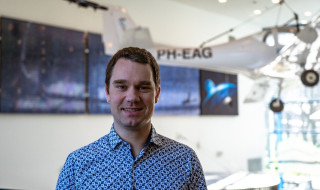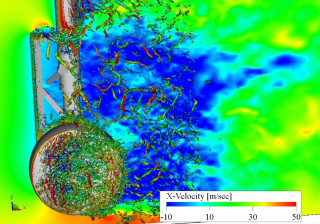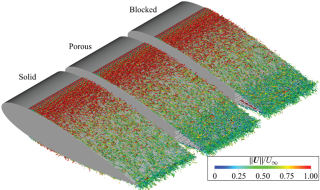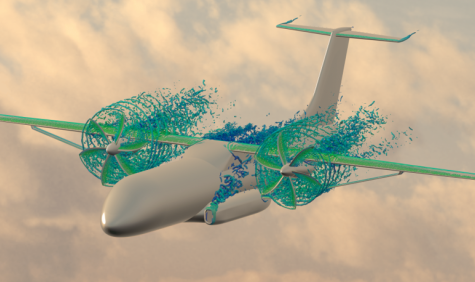Simulation of a new (and highly efficient) type of aircraft, carried out by TU Delft
Supercomputer helps to decrease sound pollution
Turn that noise down!
Together with his team of researchers in Delft, Frits de Prenter studies the sound caused by airflows when they come into contact with objects. This research, which requires considerable computing power, is contributing to the development of quieter aircraft, drones, and wind turbines.
Key facts
Who: Frits de Prenter
Function: assistant professor
Organisation: TU Delft
Service: national supercomputer Snellius
Challenge: Large, detailed simulations of aeroacoustic noise from propellers and wind turbines require enormous computing power that an ordinary desktop cannot handle.
Solution: Frits and his team use Snellius to run complex simulations, enabling a better understanding of aeroacoustic behaviour and quieter designs.
“When a propeller rotates, it creates a disturbance in the airflow. In aerodynamics, this disturbance can be described in terms of fluctuations, turbulence or vortices, but it also creates sound waves. These sound waves carry much further than the other aerodynamic phenomena. When an aircraft flies overhead, you don’t feel the airflow, but you can hear it!” We are speaking to Frits de Prenter (35), assistant professor in the Aeroacoustics team of the Wind Energy section at TU Delft.

Frits de Prenter
“Our research focuses on aeroacoustics,” he continues animatedly. “This is the sound produced by airflows caused by, for example, a propeller, wind turbine blade or aircraft wing. This creates sound waves, just like those caused by a vibrating surface in a speaker or loudspeaker. So, in principle, aeroacoustics is everywhere you can hear aerodynamics.”
Living near airports
“In addition to the engines, the landing gears of aircraft are also an interesting and important source of noise. It contains several components in series in the flow direction. The front part creates vortices. The formation of these vortices is a relatively mild source of noise. However, as soon as the vortices impinge on the second part of the landing gear, many acoustic waves are generated.
This is particularly bothersome for residents living near airports. We are trying to gain a better understanding of these phenomena and develop better techniques for predicting noise production using computer simulations and wind tunnel measurements. This allows the aviation industry to take these factors into account when designing new models.”

Visualisation of vortices created by a part of a landing gear. Simulation performed by TU Delft within the project INVENTOR (EU 8605383).
Quieter wind turbines
Research into aeroacoustics naturally extends beyond aviation. “Wind turbines also produce aerodynamic noise. Apart from the mechanical elements in the turbine, the airflow past the blades produces noise. When the air flows past the blade’s surface, the flows on both sides of the blades create turbulent fluctuations. When these two flows, each with its own turbulent fluctuations, meet at the trailing edge, this causes a sound wave.”
We ask Frits about possible solutions to reduce this noise level ‘in the air’.
“If you look at the trailing edge of a wind turbine blade, you will see that it is sometimes straight and sometimes serrated. These serrations are there to make the turbines quieter. When the serrations have the right dimensions and frequency, they break up the effect of (coherent) vortices. This means that the blade produces less noise. We are currently researching how to reduce this noise by making the trailing edge of the blade from a porous material, and to use this technique for other applications, such as aircraft wings.”

Simulation of a turbulent flow along a wing profile with one solid end, one porous end, and one porous end blocking full flow along the chord line. Simulation carried out by TU Delft within the SmartANSWER project.
Snellius for large computations
Does Frits spend a lot of time in wind tunnels, or does he mainly work with computer simulations?
“I only go to wind tunnels when I need to help out, because my interest and expertise lie mainly in numerical methods. Half the week I focus on developing algorithms, and the other half I help researchers to use those algorithms in a smart way. For some applications, we also have data that we can use for calculations.”
Is that why researchers come to SURF?
“You can develop an algorithm on a laptop. You then test it on a small calculation. However, if you want to look at industrial applications, you quickly end up with large calculations. To be able to represent individual vortices in a calculation, you need a very high resolution. Combine that with the size of an airplane wing or a wind turbine blade, and you can imagine that a lot of computing power is required. For projects like that, we come to Snellius, SURF’s national supercomputer.
That’s how we, for example, investigate the aeroacoustics of electric flight. Electric flight almost always involves propellers. If you place many propellers next to each other on a wing, they will affect each other, which causes a lot of noise. In a recent project with the Von Karman Institute in Brussels, we gained a better understanding of exactly how this noise is produced and what the important parameters are in this process. In short, what exactly is the effect of one propeller on another? What exactly happens when the propeller blades pass each other? What if you use six blades per propeller instead of two? And what if you adjust the angle? This requires a great deal of computing power.”

Simulation of the interaction between side-by-side propellers. Simulation conducted by TU Delft in collaboration with the von Karman Institute within the eVTOLution project (EU 101138209).
Flying cars
“Another area of research for which we rely on Snellius is ‘urban air mobility’ and ‘advanced air mobility’. Or, in layman’s terms, ‘flying cars’. These are relatively small vehicles with many propellers that can take off and land vertically. And they do so in or close to a built environment. Buildings and the wind around them cause a lot of turbulence. What is the effect of the interaction between the turbulence and a propeller, and what effect does that turbulence have on sound propagation?
To be able to say anything meaningful about this, you need to perform an enormous number of calculations. Simulating a single propeller at a given inflow would take several months to half a year on a normal desktop computer. On Snellius, we can calculate with the equivalent of hundreds of desktops at the same time, making this type of research feasible.
For someone who uses simulation algorithms, a high-performance computer like Snellius is not very different from a normal desktop. Snellius runs on a Linux platform with a scheduler. You have to find your way around that. People who are less familiar with Linux, because they normally work with Windows or Apple, for example, have to learn a few commands to get started. Within our team, there is always someone who can help you get started. For someone who develops the algorithms, parallelisation for high-performance computers is a completely different story, of course.”
Still a lot to discover
Finally, we ask Frits about his main motivations. What makes this work so special to him?
“First of all, I really enjoy the research, working with PhD candidates and teaching students. In addition, we only started serious research into aeroacoustics after the jet engine was invented. A lot has happened in our field in the past 75 years, but there is still a lot to learn and discover.
Technological developments such as quantum computing and AI will certainly help us in this regard. Noise pollution in our living environment is in the news regularly. Reducing this pollution is a constant focus for the industry. As a result, people who do their PhDs with us find jobs in no time. I am happy that I can play a modest role in this, together with my colleagues.”
Text: Edwin Ammerlaan
